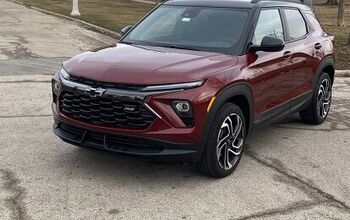Motor Trend Reveals The "Secret" To Getting 127 MPG In A Chevy Volt
Since we questioned Motor Trend’s decision to claim that it got 127 MPG in a Chevrolet Volt without publishing a trip log, the buff book has apparently come to terms with the fact that the Volt is “as efficient as you want it to be.” In a piece dismissively subtitled “ Yes, Your Mileage May Vary. Welcome to the Real World,” MT Editor-in-Chief Angus Mackenzie publishes MT’s Volt test trip log, but not before harumphing
For decades we have routinely published “MT Observed” fuel economy numbers as part of our road test data. And apart from the odd complaint that we journalists always seem to have a heavy right foot, those numbers have drawn few comments. Until our Chevy Volt test.
No surprise, perhaps. After all, 127 mpg is a pretty big number. But, as outlined on the next page, it’s a real number. It’s what we observed during our test.
Except that nobody (here at TTAC anyway) was surprised at the size of the number. Because of the Volt’s unique drivetrain, it would have been eminently possible to record 300 MPG, given enough recharges. What was surprising is that a publication would throw out a meaningless number and then wait a day (and a call-out) to condescendingly provide the raw data behind their test. And even then, still not point out that the Volt’s post-EV range efficiency (described by MT in terms of “EV/Gas miles”) was actually under 36 MPG (in line with tests conducted by MT’s buff book “peers”). Finally, it might have been appropriate for MT to explain that, on this particular test anyway, a Nissan Leaf would have needed one extra charge (over the night of the 22nd-23rd) but would have returned infinite MPG (though the 100 mile claimed range would have been properly tested on the 23rd). But there we go being inconveniently rude again… and who are we to turn up our noses at MT’s (belated) transparency?
More by Edward Niedermeyer
Latest Car Reviews
Read moreLatest Product Reviews
Read moreRecent Comments
- MaintenanceCosts Who knows whether it rides or handles acceptably or whether it chews up a set of tires in 5000 miles, but we definitely know it has a "mature stance."Sounds like JUST the kind of previous owner you'd want…
- 28-Cars-Later Nissan will be very fortunate to not be in the Japanese equivalent of Chapter 11 reorganization over the next 36 months, "getting rolling" is a luxury (also, I see what you did there).
- MaintenanceCosts RAM! RAM! RAM! ...... the child in the crosswalk that you can't see over the hood of this factory-lifted beast.
- 3-On-The-Tree Yes all the Older Land Cruiser’s and samurai’s have gone up here as well. I’ve taken both vehicle ps on some pretty rough roads exploring old mine shafts etc. I bought mine right before I deployed back in 08 and got it for $4000 and also bought another that is non running for parts, got a complete engine, drive train. The mice love it unfortunately.
- Statikboy I see only old Preludes in red. And a concept in white.Pretty sure this is going to end up being simply a Civic coupe. Maybe a slightly shorter wheelbase or wider track than the sedan, but mechanically identical to the Civic in Touring and/or Si trims.


































Comments
Join the conversation
I think you need a sliding scale showing the gallons used per mile (assuming a recharge between trips). So, assuming a 40 mile battery range and 30mpg when in gas-only mode, the Volt would look like this: [sorry about the formatting] Miles Elec.-Miles Gas-Miles gallons-used mpg 10 10 0 0.0 NA 20 20 0 0.0 NA 40 40 0 0.0 NA 80 40 40 1.3 60 160 40 120 4.0 40 320 40 280 9.3 34
That's an interesting piece of BS from MT. Odd that they didn't claim you can get infinite mpg* *keep that battery charged up! The claim that electricity is cheaper than gas is demonstrably false. As it turns out, electricity is the most expensive enegy source, $/BTU basis. Of course, what people are really interested in, is what they would pay per mile. And, the Volt does use electricity more efficiently than the ICE uses gas. Fair enough. What's the bottom line? Down here in SoCal, electricity is ~$0.20/kWh. The Volt has a 16 kWh battery, but only uses ~50% of the capacity, so its ~$1.60 per charge. If the EV only range is ~35 miles, that translates into $0.046/mile. That's EV mode only. Once you get to CS mode, @35 mpg and the local gas price of ~$3.15/gal, you're up to $0.090/mile. It's clear that MT is right on that score: Volt owners would want to keep the battery charged, if money is any concern. Now, if you're the green-hued type of individual who might be interested in the Volt (as opposed to the money-is-no-objection Wall Street banker type), you'd be curious how the Volt compares to other greenish offerings. That would be the Prius, which is reported to get 50 mpg (by Uncle Sam, so you know it's a true number, ha ha; why no 2011 model?). At the stated gas price, that translates to $0.063/mile. Bottom line: for the Volt to even make sense in operating cost terms (say you got it as a gift from a rich uncle [Sam]), you'd need to do no more than ~40% of your driving in CS mode. Impressive? Your call...